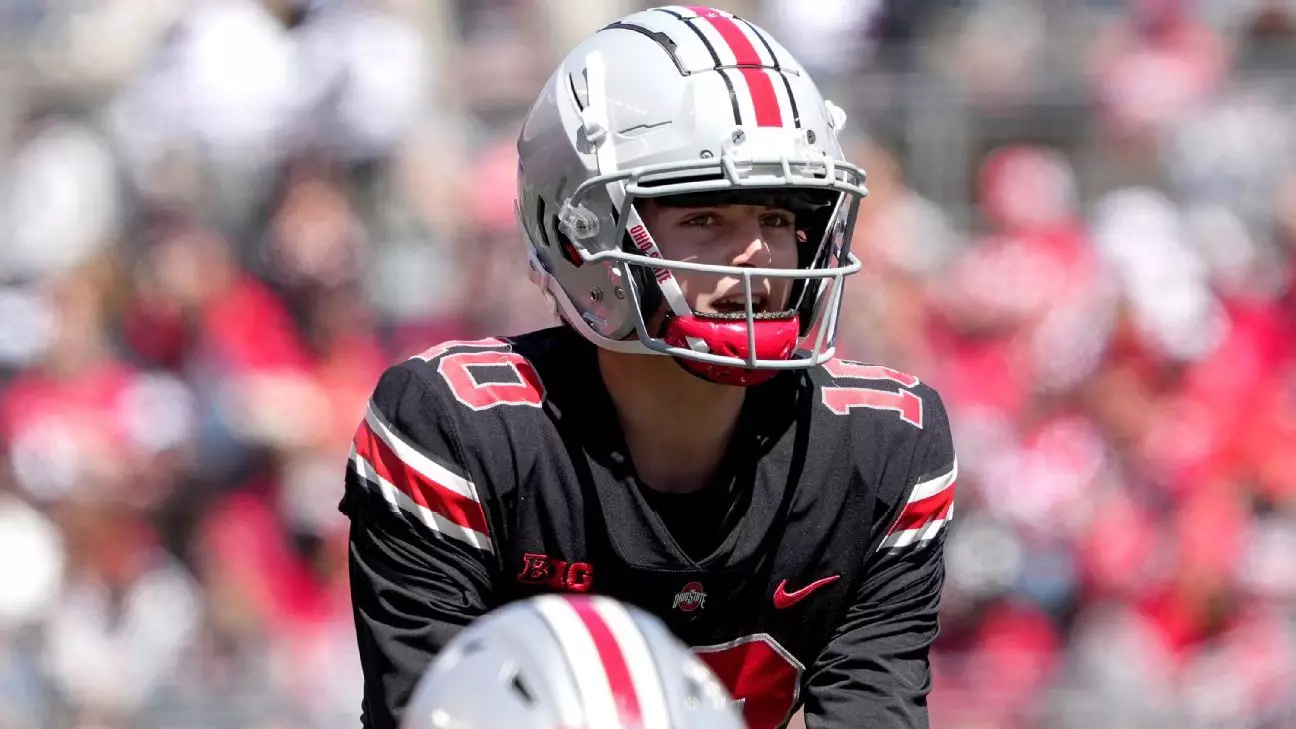In the tumultuous landscape of college football, Ohio State’s recent quarterback announcement exemplifies the often superficial allure of stability when, beneath the surface, the reality is just the opposite. Declaring Julian Sayin as the starter for the season opener against Texas seems like a move toward reassurance, but a closer look reveals deeper issues within the program. The decision, carried out amidst stiff competition and recent team dynamics, underscores a troubling tendency of programs to cling to supposed consistency rather than embracing genuine resilience. It raises uncomfortable questions about the true readiness of the team and whether superficial choices mask deeper weaknesses that could be exploited against top-tier opponents.
This choice hinges on marginal improvement and the perpetuation of the narrative that the most recent streak of success guarantees future performance. Ohio State’s coaching staff, in effectively crowning Sayin without unequivocal dominance, risks fostering complacency. A true champion would demand unequivocal dominance in practice; instead, what we have is a decision rooted in incremental gains, arguably more driven by narrative comfort than strategic certainty. The notion that a quarterback can simply “separate himself” over a week is overly simplistic, ignoring the complexities of true game readiness, especially against a powerhouse like Texas. Such decisions often project confidence, yet they often reflect a program that fears uncertainty more than it values authentic competition.
The Illusion of Talent and the Mirage of Readiness
What stands out most in this situation is the emphasis on potential rather than proven performance. Sayin, the top recruit and a high-profile transfer, symbolizes the modern football myth—youthful talent equated with immediate excellence. Yet, in the four games he has played, his numbers are modest, and his experience is limited. Meanwhile, Lincoln Kienholz, despite his sparse recent playing time, demonstrated tangible athletic traits that could have been invaluable in a high-stakes opener. Recognizing talent is one thing; translating that talent into game-winning performance is entirely different.
The coaching staff’s reliance on ‘consistency’ as a primary criterion effectively dismisses the unpredictable nature of football, especially at the college level, where mental resilience and adaptability are as crucial as physical talent. The decision to elevate Sayin does little to instill confidence that Ohio State has genuinely addressed the core issue of quarterback development—converting potential into consistency under pressure. It’s a gamble dressed up as strategic planning, one that might backfire against a disciplined, aggressive Texas squad, eager to exploit any vulnerability in Ohio State’s thinly veiled plans.
The Underlying Myth of Confidence and the Reality of Crisis
There is an undercurrent of complacency in how Ohio State handles quarterback depth and preparation. Declaring Sayin as the starter might be a tactical decision meant to project confidence both internally and externally, but it glosses over the fact that this decision is based on what amounts to a closely contested competition rather than a clear, undeniable leadership edge. Such superficiality can be dangerous. It suggests a lack of genuine conviction in the process, fostering a fragile environment where players might not be fully committed to a cohesive team effort, knowing that the hierarchy is somewhat arbitrary.
Coach Ryan Day’s statements about both quarterbacks being ready reveal a desire to maintain harmony, but they also underscore an unsettling reality: the team’s fate may hinge on factors beyond talent—mental toughness, experience, and the ability to adapt on the fly. Placing a relatively inexperienced Sayin as the primary option against a top-tier team like Texas is a risk rooted more in gamble than certainty. If the season’s early games reveal weaknesses, critics will rightly ask whether Ohio State’s leadership truly understands the peril of relying on potential rather than proven performance.
The Cost of Choosing Comfort Over Challenge
Ohio State’s approach reflects a broader cultural issue pervasive in college sports—favoring safe, predictable decisions over bold, challenging ones. By avoiding the difficult task of truly developing Kienholz or the promising freshman Tavien St. Clair, the program reveals a preference for quick fixes rather than sustainable growth. This mindset can produce short-term comfort but hampers long-term success, especially against formidable opponents who thrive on forcing mistakes and exploiting uncertainty.
This episode also highlights a philosophical dilemma: should teams prioritize winning now, or focus on cultivating resilient, adaptable athletes who can thrive under pressure? Ohio State’s decision suggests the former, but history demonstrates that shortcuts often come at a steep cost. If the quarterback struggles against Texas—a team that has its own issues but boasts undeniable talent—the fallout could tarnish Ohio State’s reputation and destabilize the program. The danger lies less in the choice itself and more in the overconfidence it fosters, a confidence rooted more in hope than in solid evidence.
—
This analysis reveals that Ohio State’s quarterback choice, while superficially confident, is rooted in an overreliance on potential, a reluctance to confront uncertainty, and a troubling preference for comfortable narratives over strategic rigor. It underscores the necessity for programs to confront their vulnerabilities honestly rather than masking them with superficial decisions driven by short-term optimism.


Leave a Reply